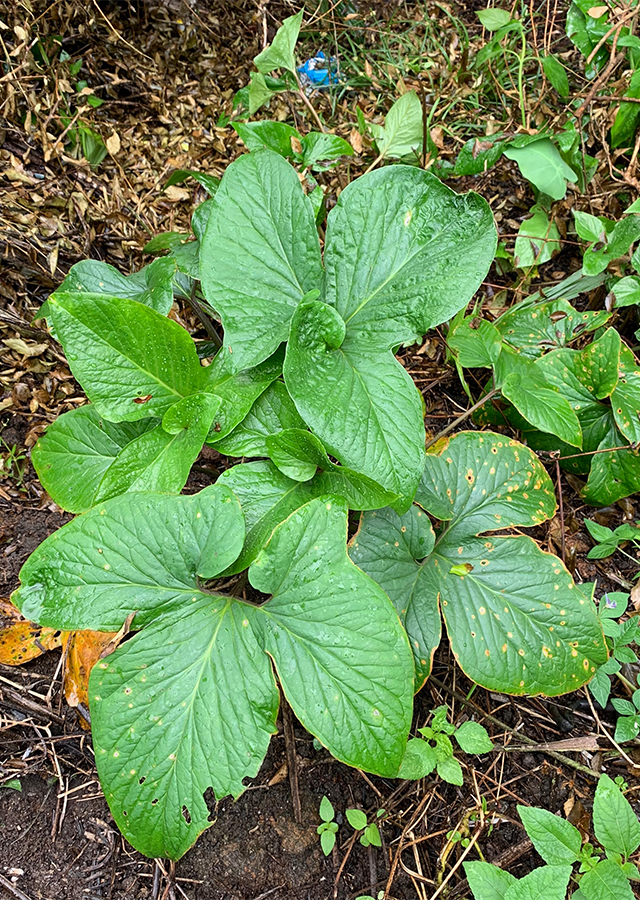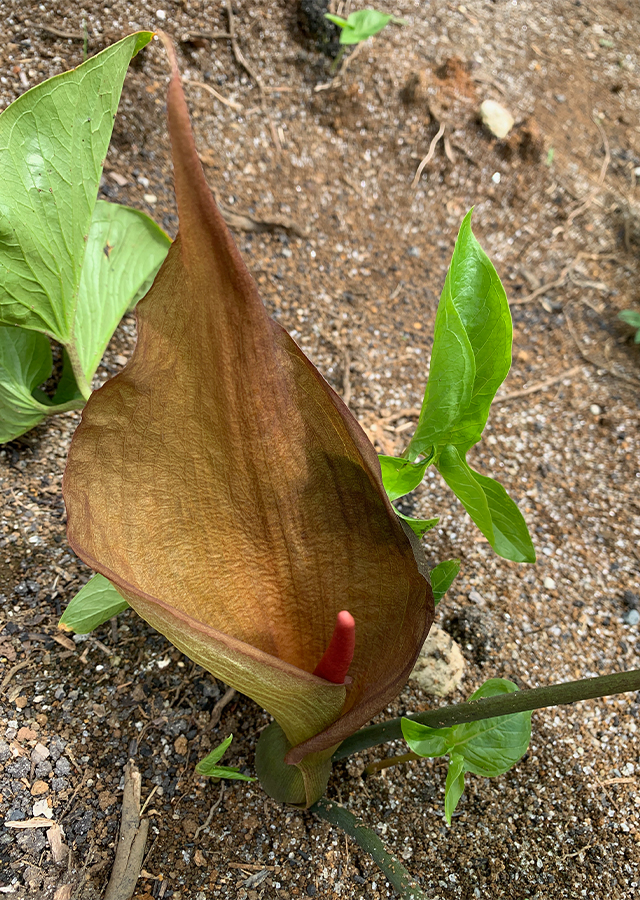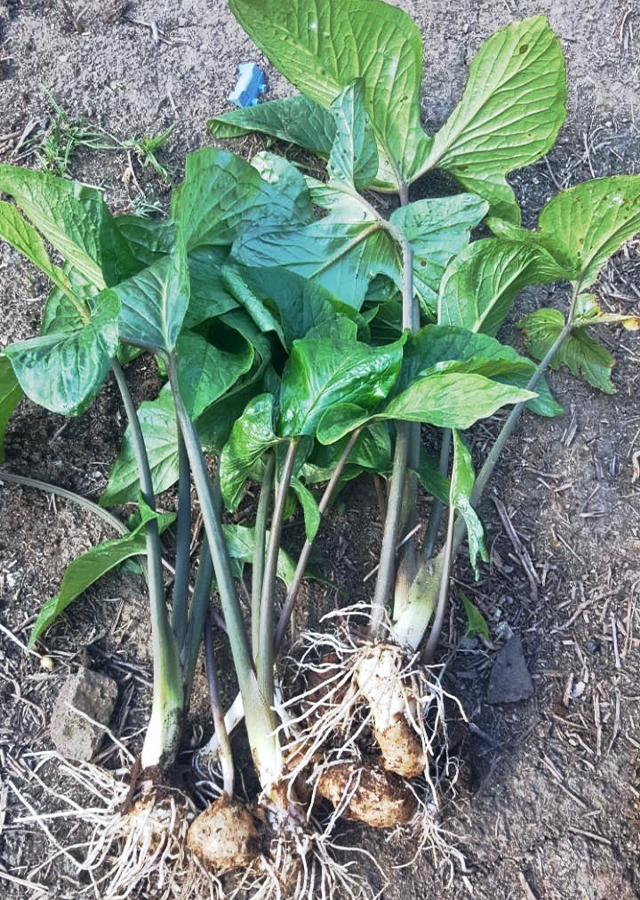Bengal Arum
Typhonium trilobatum (L.) Schott
Araceae
Location in our garden
Principal



Synonym
Arisaema pumilum Blume
Arum auriculatum Sims
Arum foetidum Salisb.
Habitus
Herbaceous. An herbaceous plant with short tuberous corms grows up to 45 cm tall.
Part Used
Leaves
Roots
Tuber
Growing Requirements
Need Shade
Habitat
Wetland
Grassland
Terrestrial
Overview
Bengal arum (Typhonium trilobatum) is the native range in India to South China and Malaya. It is widely grown in India, Bangladesh, China, Thailand, Vietnam, Malaysia, and Srilanka for its rhizomes, leaves, and petioles. The plant is grown in South India for the rhizome which is eaten. Other species are similarly eaten in the Australasian region. The fresh rhizome is very acrid and is a powerful stimulant. The plant contains soluble calcium oxalate.
Vernacular Names
Anaiyatikkaku (Hindi), Sam ghas (Assamese), Tharkun (Bengali), Ma ti li tou jian (Chinese), Ghatkol (Bangladesh).
Agroecology
T. trilobatum is found in tropical secondary forests, thickets, grasslands, roadsides at low altitudes up to 1,000 m above sea level. It prefers growing in semi-shade, full sun with moderate water. It is a weed occurring in open sites and in the lowland, often on wet soils, also on limestone.
Morphology
- Roots - a short, tuberous rhizome.
- Stems - subglobose or subcylindric, producing few annual offsets or splitting up.
- Leaves - leaf blade cordate-ovate in outline, usually deeply 3-lobed, rarely 5-lobed. Petiole green or variously flushed with purple, 25–40 cm.
- Flowers - Inflorescence a spadix; peduncle 5 cm long; spathe 10-20 cm, with dark red limb; spadix with 1 cm pistillate part, sterile part 1-2 cm long and covered with whitish intertwined filamentous sterile flowers, naked interstice 1-2.5 cm, staminate part 2-3 cm long, appendix 5-10 cm long and dark red.
- Fruits - berries, green with purple spots, turns white when mature, ellipsoid, contains 1-2 seeds.
- Seeds - white when mature, ellipsoid, 1- or 2- seeded.
Cultivation
- It can be propagated by seed. Remove seeds from the berry which contains chemicals that inhibit germination.
- It is also can be propagated by offsets.
Chemical Constituents
Thiamine, niacin, carotene, folic acid, sterols, β-sitosterol, flavonoid, phenol compounds, alkaloids, glycosides.
Traditional Medicinal Uses
- The leaf extract is used in treating diarrhea, pain, and inflammation.
- It is good for analgesic, anti-inflammatory, and anti-diarrheal.
- The roots are used in the treatment of stomach troubles, hemorrhoids, tumors, and cancers.
- The rhizome of this plant is traditionally prescribed for the treatment of skin eruption, gastric ulcer, asthma, headache, swelling, excessive expectoration, traumatic injury, lymph tuberculosis, chronic bronchitis, vomiting, cough, pyogenic sore throat, rheumatism, abscess, and snakebite, diarrhea, dysentery, stimulant, and menstrual troubles.
- Leaves and tubers are cooked as vegetables and given to the patient suffering from piles and rheumatism.
Part Used
Reference Sources
- Ali, K., Ashraf, A., & Biswas, N.N. (2012). Analgesic, anti-inflammatory, and anti-diarrheal activities of ethanolic leaf extract of Typhonium trilobatum L. Schott. Asian Pacific Journal of Tropical Biomedicine 2(9): 722–726.
- Chuakul, W., Soonthornchareonnon, N., & Ruangsomboon, O. (2016). Typhonium trilobatum (PROSEA). In: Plant Resources of South-East Asia (PROSEA), Groen, L.E., Siemonsma, J.S., & Jansen, P.C.M. (eds.). Plant Resources of South-East Asia (PROSEA) Web. https://uses.plantnet-project.org/en/Typhonium_trilobatum_(PROSEA) (Accessed 01-03-2021).
- JSTOR. (2021). Global Plants Database: Typhonium trilobatum (Linn.) Schott. JSTOR Web. https://plants.jstor.org/stable/10.5555/al.ap.upwta.1_452 (Accessed 25-02-2021).
- NParks Flora & Fauna. (2021). Flora & Fauna Web: Typhonium trilobatum (L.) Schott. NParks Flora & Fauna Web. https://www.nparks.gov.sg/florafaunaweb/flora/8/3/8385 (Accessed 25-02-2021).
- Plants of the World Online. (2021). Plants of the World Online Database: Typhonium trilobatum (L.) Schott. Kew Royal Botanic Gardens. http://www.plantsoftheworldonline.org/taxon/urn:lsid:ipni.org:names:89268-1 (Accessed 25-02-2021).
- The National Gardening Association Plants Database. (2021). Typhonium trilobatum. The National Gardening Association. https://garden.org/plants/view/243546/Typhonium-trilobatum/ (Accessed 25-02-2021).


